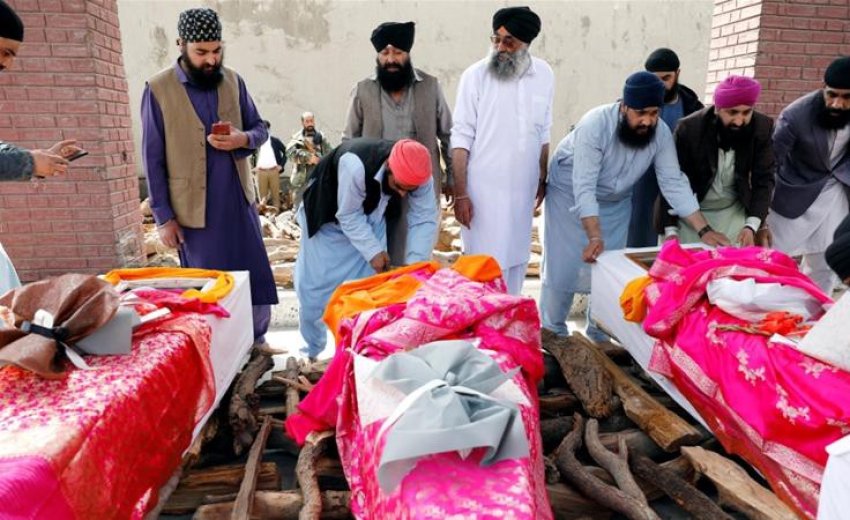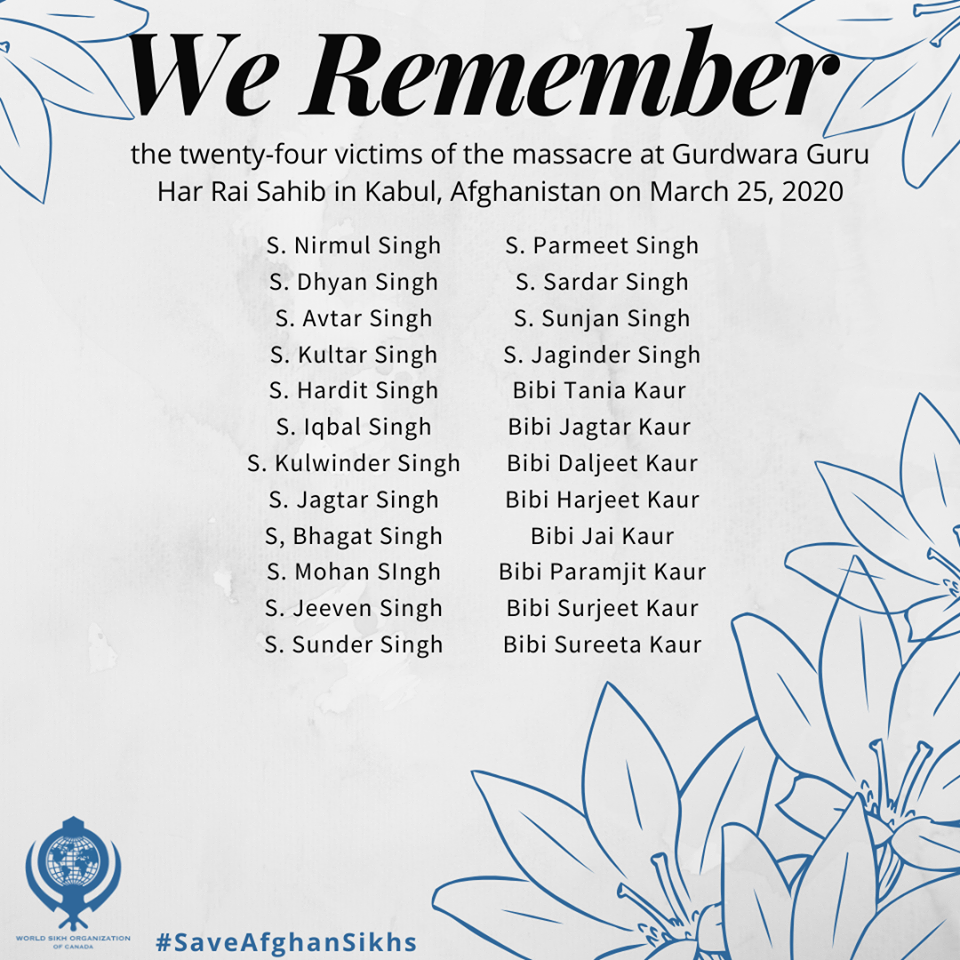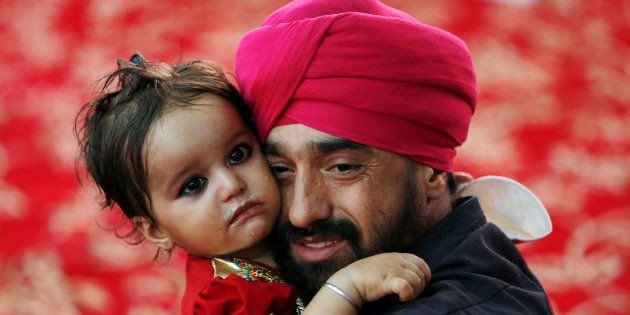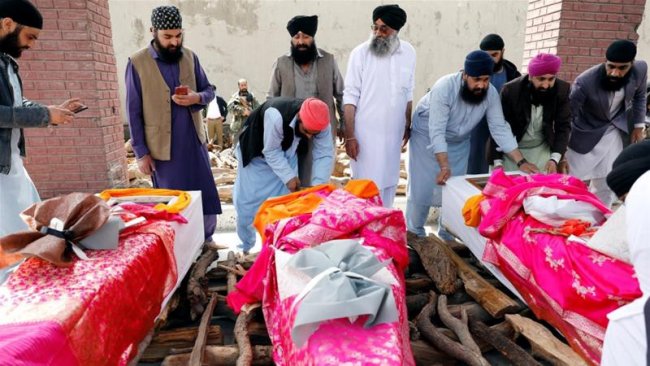Last Wednesday, terrorists were reported to have entered a Sikh gurdwara in Kabul, holding those gathered hostage, promising and delivering violent deaths to ‘infidels.’ Hours later, 25 men, women, children had been killed, leaving dozens others to wash rivulets of blood running down the gurdwara floor. Then, an attempted bombing targeted the mourners of the dead at the site of the multiple cremations. A day later, further morbid threats against the terrorized Sikh minority (indigenous to Afghanistan since the early sixteenth century) were followed by another reported bombing of a Sikh gurdwara.
Sikhs, people sharing a 550-year-old faith, live vibrantly varied lives but also share several inheritances. Including trauma. Last week’s attacks reminded us all that the most insidious human contagions don’t pause for any pandemic. These attacks rekindled for some trauma-responses, old and new.
courtesy: World Sikh Organization
For any survivors of trauma, including those of secondary or vicarious trauma, defining a path and sticking to a plan, takes concerted and draining effort. Today, Sikhs are attempting to keep the focus on the immediate victims: the Sikhs in Afghanistan are easy targets, must be removed to safer sites. Some Sikhs are actively working toward the overdue safe international relocation of the remaining approximately 75 Sikh Afghan families. Following the efforts of the Alberta MLA Manmeet Singh Bhullar, who started Afghani Sikh and Hindu resettlement efforts prior to his death in 2015, the Canadian government has relocated 15 families. But other families’ files have been caught up in bureaucratic red tape. Now, many Canadians, led by the World Sikh Organization, are pushing for expedited action and direct sponsorship. And they are asking the world to join the call. Allowing the remaining Afghan Sikh families to become fodder for hate politics, or expendables in spy games that might serve seemingly unrelated ends, is unacceptable to Sikhs who have also inherited a mandate to live large lives, no matter how small their numbers.
Despite lack of consensus around the definition of ‘minority’ in international law, the 1979 description offered in the UN Study on the Rights of Persons Belonging to Ethic, Religious and Linguistic Minorities, by Special Rapporteur Francesco Capotorti, applies to Sikhs living in any country of the world: “A group numerically inferior to the rest of the population of a State, in a non-dominant position, whose members — being nationals of the State — possess ethnic, religious or linguistic characteristics differing from those of the rest of the population and show, if only implicitly, a sense of solidarity, directed towards preserving their culture, traditions, religion or language.”
In the South Asian subcontinent, the suggestion that Sikhs held a non-dominant position relative to the State would have been unacceptable to the Sikh community’s ears pre-1947’s creation of modern India. After all, Punjab, ruled by the Sikh statesman Ranjit Singh, was the last kingdom to fall to the British colonials. Then, through the colonial rule, numeric population increasingly becamethe primary basis for communities’ relative power. The Sikh community was sidelined in the negotiations that led to the Partition of the subcontinent in 1947. Subsequently, the minoritization of Sikhs in their own homeland of Punjab, was accelerated, at grave human cost.
The late 1970s to mid-1990s expanded the rural Punjabi lexicon to include “police encounters,” when anywhere from 25,000 (police estimates) to 250,000 (civil society estimates) were killed. In the watershed year of 1984, Sikhs saw their gurdwaras across North India being overrun by the Indian Army, as pilgrims and visitors alongside protestors, men, women, children, able-bodied and not, became enemies. They were ‘infidels’ by Indira Gandhi’s Congress’s breed of nationalism and leader-worship. In the following decades, even cremation ceremonies of murdered Sikhs — especially alleged ‘militants’ — were banned by the government, or used as opportunities for further arrest and terror.
The post-1984 fear had quickly morphed Sikhs’ sense of their own reality. First outside Punjab, then later inside as well, the Sikh community was effectively “gaslighted”: like an abuser often succeeds in making a victim of domestic violence question her own sanity, memories, values, and truths, this community was made to lose confidence in its own beliefs and experience. Sikhs increasingly found alternative explanations that did not implicate the abusers. Even when someone was deemed an ‘innocent victim’ — a casual bystander or even a child picked up and tortured to punish or extort their parents — even then, the blame for why the community was being victimized as whole was levied by the community on itself. Not an unusual trauma-response.
This week, we’ve seen a range of responses. There is shame at not having been able to do more for Sikhs living as expendable scapegoats in the quagmire of Afghanistan. There is silence (a respectable, if limited, survival tactic) in face of the knowledge that people who look and pray like you have been targeted, again, just for existing. There is anger at why the small number of directly threatened families have not yet been successfully moved to relative safety. There is fatalistic over-simplification: after 1947’s Sikh-Muslim Partition violence and the selective storytelling by both sides, in India and Pakistan, these communities can never co-exist. There is the idealist over-correction ignoring the lived reality of Afghani Sikhs: that the majority of Afghani Muslims care for their Sikh brethren, only these extremists do not. There is confusion as to the facts: multiple gunmen were first reported but now only one, that too with an Indian and Kashmiri connection, is noted. There is judgement on each response: not angry enough; too angry; not emotional enough; too scared. And there is the deep tiredness, uncured by sleep, of more terrorized children joining a wretched caravan in our nightmares.
There is also a response to the trauma that would have been impossible without the generations that came before us. A response that has been made possible by embracing trauma not as a weakness, but as a lens for introspection, compassion, and propulsion. Sikhs have also responded with alacrity. There has been a refusal to be manipulated. And a more confident realization: if we don’t protect the minorities within, who will?
Always non-dominant in numbers, Sikhs have throughout South Asian history disproportionately made their presence felt in response against aggression by the powerful. This too is Sikh inheritance. 2020 has been no different. As protests grew against barely-shrouded anti-Muslim changes to the citizenship laws by the current BJP government in India, Sikhs displayed visible solidarity. Serving langar — a tradition of feeding communally-prepared meals to anyone in need; sleeping in the bitter winter with the Muslim protestors; standing in solidarity with the sit-ins at Shaheen Bagh; and edicts against anti-Muslim actions were issued by the highest seat of Sikh authority (the Akal Takht). Then, as anti-protestor, anti-Muslim violence erupted on the streets of Delhi and elsewhere, Sikhs put their lives on the line to transport and protect the persecuted.
Now, as the news from Kabul began emerging, a BJP minister believed to be at the center of provoking the violence in Delhi that claimed over 50 lives and left hundreds of Muslims destitute or jailed, tweeted: “What would those who were distributing langar in Shaheen Bagh be thinking today?”
Sikhs, since 1984, are no stranger to being blamed for their own victimization. The spite towards the victim-survivor is a trend familiar to the streets of Delhi past and present. Sikhs have responded fiercely to this obvious attempt at instilling self-doubt and shoving towards Sikh-Muslim animosity. Many Sikhs commentators promise an allegiance to their faith’s tradition of langar, and against those attempting to employ the dastardly anti-Sikh attacks in Kabul to forward the dangerous anti-Muslim policies in India.
Many Sikhs cannot help but comment on possibly invisible hands behind the Kabul attacks. After all, when Sikhs were executed in Kashmir in 2000 coinciding with President Clinton’s State visit to India, and Muslim ‘terrorists’ immediately blamed and summarily executed, mysterious questions that arose were substantiated years later. Wrote Khushdeep Kaur Malholtra on the twentieth anniversary of that massacre a fortnight ago: “While media, researchers like myself, guests curious to know its history, and even anniversaries come and go, answers to what happened and why remain elusive. So does the hope that these answers will ever come.”
Alternate theories of hidden games are all the more difficult to ignore when tweets such as this are circulated by right-wing Hindutva commentators: “Sikhs murdered in Kabul Gurudwara. If you’ve supported and fed langars to those rioting against the Citizenship Amendment Act, then this bloodbath is on you.”
Sikh twitter has been alit with responses promising continued solidarity with anyone persecuted and highlighting — as did human rights lawyer Guneet Kaur — the shameful actors “trolling us as we mourn.” Ravinder Singh, head of the relief organization serving zones of war and natural disasters worldwide wrote: “Our Gurus never differentiated between MUSLIM, HINDU or SIKH where LANGAR was served … We see our Guru in every hungry soul, we are our Gurus Sikhs.”
These voices are joined by seas of others from around the world reflecting hope for a generation refusing to remain silent witness to inter-generational trauma. The imminent danger faced by Afghan Sikhs calls this resolve to immediate action.




